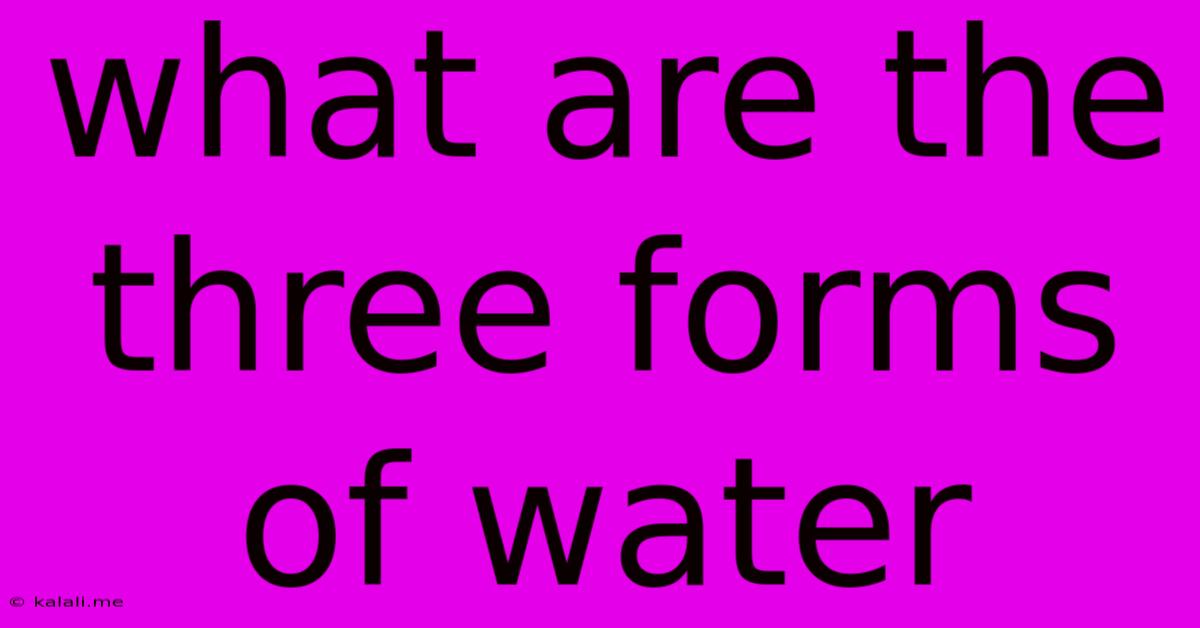What Are The Three Forms Of Water
Kalali
Jun 15, 2025 · 3 min read

Table of Contents
What Are the Three Forms of Water? A Comprehensive Guide
Water, the elixir of life, exists in three primary forms: solid, liquid, and gas. Understanding these forms and the transitions between them is crucial to grasping many fundamental scientific concepts, from weather patterns to the water cycle. This article will delve into each form, explaining its properties and how it relates to the overall water cycle.
This article will cover: the characteristics of each state of water, the processes that cause phase changes, and the importance of water's unique properties for life on Earth. It also provides examples of each water state in everyday life.
1. Solid Water: Ice
Ice is the solid form of water, formed when water molecules lose enough energy to slow down significantly and bond together in a rigid, crystalline structure. This structure is less dense than liquid water, which is why ice floats. This seemingly simple property has profound implications for aquatic life; if ice sank, bodies of water would freeze solid from the bottom up, making life unsustainable.
Key characteristics of ice:
- Rigid structure: Water molecules are locked in a fixed arrangement.
- Low density: Ice is less dense than liquid water.
- Brittle: Ice can fracture under stress.
- Variable forms: Ice can exist in different crystalline structures depending on temperature and pressure.
2. Liquid Water: The Universal Solvent
Liquid water is the most familiar form of water. In this state, water molecules are still relatively close together but move freely, allowing water to flow and take the shape of its container. This is the state where water demonstrates its impressive solvent properties, dissolving a wide range of substances, making it essential for biological processes and chemical reactions.
Key characteristics of liquid water:
- High surface tension: Water molecules are strongly attracted to each other.
- High specific heat capacity: Water can absorb a large amount of heat without a significant temperature change.
- Excellent solvent: Dissolves many ionic and polar substances.
- High viscosity: Resists flowing.
3. Gaseous Water: Water Vapor
Water vapor is the gaseous form of water, formed when liquid water absorbs enough energy to overcome the intermolecular forces holding its molecules together. This process is called evaporation. Water vapor is invisible; what we often see as "steam" is actually tiny droplets of liquid water condensed from the vapor. Water vapor plays a crucial role in the Earth's atmosphere and weather patterns.
Key characteristics of water vapor:
- Invisible gas: Cannot be seen with the naked eye.
- Low density: Water molecules are far apart.
- Contributes to humidity: The amount of water vapor in the air.
- Part of the water cycle: Essential for precipitation and cloud formation.
The Water Cycle: A Continuous Transformation
The three forms of water are constantly transitioning between states in a continuous process called the water cycle. Evaporation turns liquid water into vapor, condensation transforms vapor back into liquid, and freezing changes liquid water to ice. These transitions are driven by changes in temperature and pressure, demonstrating the dynamic nature of water and its vital role in maintaining the Earth's ecosystems.
Understanding the three states of water and the processes that govern their transformations is crucial for appreciating the complexity and importance of this essential substance for life on our planet. From the smallest cell to the largest ocean, water’s unique properties in its three forms are fundamental to the functioning of our world.
Latest Posts
Latest Posts
-
Which Of The Following Is Not One Of The
Jun 15, 2025
-
Which Of The Following Is A Steroid Hormone
Jun 15, 2025
-
What Is The Measure Of Angle E
Jun 15, 2025
-
Lines Of Symmetry Of A Regular Hexagon
Jun 15, 2025
-
The Function Of The Dartos And Cremaster Muscles Is To
Jun 15, 2025
Related Post
Thank you for visiting our website which covers about What Are The Three Forms Of Water . We hope the information provided has been useful to you. Feel free to contact us if you have any questions or need further assistance. See you next time and don't miss to bookmark.